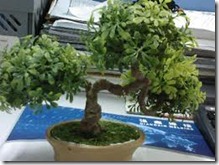 Most sources on the history of bonsai trees note that a bonsai tree is literally a "plant in a pot" in Chinese. According to Harvard’s Arnold Arboretum site, "the ancient Chinese were the first to miniaturize trees for ornamental purposes, around A.D. 200." Later, bonsai trees were used in Japanese gardens. Other art forms involving persistent pruning to shape plants are espalier and topiary.
Most sources on the history of bonsai trees note that a bonsai tree is literally a "plant in a pot" in Chinese. According to Harvard’s Arnold Arboretum site, "the ancient Chinese were the first to miniaturize trees for ornamental purposes, around A.D. 200." Later, bonsai trees were used in Japanese gardens. Other art forms involving persistent pruning to shape plants are espalier and topiary.
Care of Bonsai Trees
Some species, such as the junipers and maples, are hardy enough for growing outside in Japanese gardens in the colder climate zones, while other species make good indoor plants. Ficus and Norfolk Island pine are among the latter.
Miniaturization is accomplished through rigorous regulation of a bonsai tree’s growing conditions.Scaffold branches are selected early on as the only branches to be allowed to prosper, while the excess branches are mercilessly pruned off. Bonsai trees are intentionally allowed to become root-bound in their containers, and the roots, too, are pruned. But root-bound plants won’t thrive forever in that condition and, indeed, bonsai trees must be re-potted every two or three years to furnish the roots with fresh soil.
Pruning of branches is performed in spring. Much, but not all of the new growth is removed. Desirable branches are wired to control the direction in which they grow. Bonsai tree wiring is an advanced skill; consult the manuals provided by bonsai tree clubs.
Fertilize bonsai trees with a water-soluble fertilizer once or twice per month during the growing season. Your choice of fertilizer may vary depending on the species you’ve chosen to miniaturize. Apply fertilizer when the soil is wet.
How often you should water is a common question people ask about plants in general, and bonsai trees are no exception. Unfortunately, as for other plants, there’s no hard-and-fast rule, since conditions vary so widely. When the soil begins to dry out, weigh your potted bonsai tree on a scale, and make a notation of the result for future reference. Then water thoroughly — meaning excess water will run out of the bottom of the pot, signifying you’re done. Weigh the now well-watered bonsai tree again, and record the figure. Compare it to the figure obtained for the dry plant. In the future, when in doubt, you can weigh the plant, and compare the result to those two figures you’ve recorded, using the figures as guidelines as to whether the bonsai tree needs water right away or could go without a bit longer. Remember, over-watering is as bad as under-watering, thus all the fuss about getting it just right.

Deprecated: strpos(): Passing null to parameter #1 ($haystack) of type string is deprecated in /home/agriviek8Qv/agriviet.net/public_html/wp-includes/comment-template.php on line 2522